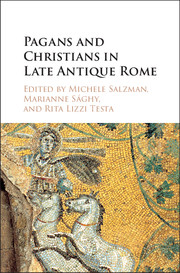 Pagans and Christians in Late Antique Rome
Pagans and Christians in Late Antique Rome Published online by Cambridge University Press: 05 November 2015
This volume reassesses the historical paradigm of relations between pagans and Christians by focusing on the evidence from fourth-century Rome. This topic has taken on new resonance due in large measure to the reinvigoration of the debate over historical models fueled by the 2011 publication of Alan Cameron's important book, The Last Pagans of Rome. Cameron has argued that the concept of pagan–Christian religious conflict in Rome is a pure historiographical construction – the remnants of the scholarship disseminated by Hungarian scholar András Alföldi, who presented a Christian Constantine in irreconcilable conflict with a pagan Rome. Inspired by long-standing traditions of the Hungarian nobility rebelling against Habsburg emperors, Alföldi's “conflict model” conveyed a significant political message in a time when a frightening “new paganism” seemed to be spreading from above. Two years later, in a seminar at the Warburg Institute in London, Herbert Bloch broadened the idea of pagan–Christian conflict and saw evidence for an aristocracy in Rome faced with a tightening of measures against traditional cults. Bloch proposed that there had been a “pagan revival” in which Rome's aristocrats led “the last pagan army of the ancient world” against the Christian emperor Theodosius I. His view became really influent only when his paper, in a shorter version, was published as a part of the seminar at the Warburg Institute in London.Alan Cameron has meticulously attacked this model in his book through a series of studies on a wide variety of texts associated with the last pagans of Rome, the powerful Roman aristocracy who allegedly spearheaded this resistance at the end of the fourth century.
Cameron's publication has aroused a strong response, especially on the part of European scholars. Some have taken the view advanced by Stéphane Ratti that the idea of pagan resistance provides a better method for explaining the literary texts of the fourth century as well as the world that produced these texts. In light of such work, the debate on the interpretation of the evidence from fourth-century Rome has gained a new effervescence.
The papers presented at the international conference held in September 2012 at the Hungarian Academy in Rome, and featured as chapters in this volume, attest to this. Their focus is on Rome in part because modern historiographic paradigms arose in relation to Rome, its aristocracy, and its Christian leaders.
To save this book to your Kindle, first ensure [email protected] is added to your Approved Personal Document E-mail List under your Personal Document Settings on the Manage Your Content and Devices page of your Amazon account. Then enter the ‘name’ part of your Kindle email address below. Find out more about saving to your Kindle.
Note you can select to save to either the @free.kindle.com or @kindle.com variations. ‘@free.kindle.com’ emails are free but can only be saved to your device when it is connected to wi-fi. ‘@kindle.com’ emails can be delivered even when you are not connected to wi-fi, but note that service fees apply.
Find out more about the Kindle Personal Document Service.
To save content items to your account, please confirm that you agree to abide by our usage policies. If this is the first time you use this feature, you will be asked to authorise Cambridge Core to connect with your account. Find out more about saving content to Dropbox.
To save content items to your account, please confirm that you agree to abide by our usage policies. If this is the first time you use this feature, you will be asked to authorise Cambridge Core to connect with your account. Find out more about saving content to Google Drive.